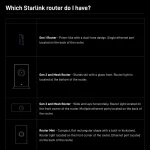20 Additional Eutelsat OneWeb LEO Broadband Satellites Launched UPDATE

Eutelsat has confirmed that they’ve launched an additional 20 satellites, on the back of a SpaceX Falcon 9 rocket, to join their global network of OneWeb broadband satellites in Low Earth Orbit (LEO), which is a constellation that has been partly supported by the UK government. This is despite the network supposedly being completed last year.
OneWeb (aka – Eutelsat OneWeb) previously had 634 small (c.150kg) first generation (GEN1) Low Earth Orbit (LEO) platforms in space – orbiting at an altitude of 1,200km above the Earth (588 of them for coverage and the rest for redundancy). The network was technically completed in March 2023 (here), promising both ultrafast broadband speeds and fast latency times, but a further 15 satellites (plus one GEN2 prototype) were then added in May 2023 to add “resiliency and redundancy to the network” (here).
The May 2023 launch was heralded as the last one needed to “deliver global coverage“, so it came as a bit of a surprise when we noticed (X) – without any press releases being issued (either directly to us or via OneWeb’s website) – that the operator had suddenly lofted an additional 20 GEN1 satellites into low earth orbit on Saturday (19th Oct 2024). But to be fair they did mention it on their launch page, albeit without giving much context.
Advertisement
The move takes their total satellite count to 654, which is slightly more than the 648 that was originally proposed some years earlier. We assume this is needed to ensure proper and reliable global coverage and capacity, without needing to compromise on any gaps due to previously having delivered slightly less than originally planned.
Meanwhile, a tentative ambition still exists for OneWeb to deploy a total of 2,000 satellites (although they could go beyond that) and 1,280 of those will be the future GEN2 model that could sit in a higher Medium Earth Orbit (MEO) of 8,500km, which are widely expected to have more data capacity, support 5G mobile and may, possibly, introduce enhanced navigation and positioning features (something the UK government wants).
The upside of being placed into a higher orbit is that each satellite will be able to cover a much wider area of the Earth’s surface, although the downside is that performance (mainly latency) will suffer. But it is possible to balance this by using LEOs for latency intensive applications (e.g. multiplayer video games, voice calls) and MEOs to help with more data transfer intensive activities (e.g. file downloads and video streaming).
The catch is that the Eutelsat Group isn’t exactly flush with spare cash at the moment (there’s quite a big debt issue) and thus much may depend upon what approach the EU takes to growing their own IRIS 2 LEO constellation, which may or may not choose to link that with Eutelsat – assuming it even goes ahead in the first place.
Advertisement
UPDATE 6:48am
Eutelsat OneWeb has now put out a press release and included a quote.
Eva Berneke, CEO of Eutelsat Group, said:
“We are delighted to see the successful launch and deployment of new OneWeb satellites. These satellites will strengthen our network services, improving overall performance for our customers. As we celebrate the anniversary of the merger with Eutelsat and OneWeb, we are excited by the growing demand for our multi-orbit services and we remain committed to delivering value for our customers and shareholders. I want to thank and congratulate the teams at Eutelsat Group and SpaceX for their hard work to facilitate this launch.”
Mark is a professional technology writer, IT consultant and computer engineer from Dorset (England), he also founded ISPreview in 1999 and enjoys analysing the latest telecoms and broadband developments. Find me on X (Twitter), Mastodon, Facebook, BlueSky, Threads.net and Linkedin.
« Gas Leak Adds to Openreach’s Petrol Leak Headaches in Bramley UPDATE






















































These Satellite Broadband are too expensive at the moment current model is not for your average user mostly people who really need broadband who live in rural areas.
To be viable business I say sign councils and housing associations, landlords install few satellite dish or a one big one is installed we just connect via the socket installed in every property alternative to wired Fibre.
But one problem I see being communal is do we have our own line like how fibre is or it might just cause slow downs during peak times.
If this can be done I thinks it’s a quicker ways of getting faster broadband in MDU buildings cost effective but let’s see how the future holds.
oneweb isn’t doing the starlink model. their idea is that telcos could use it as backhaul, eg a mobile operator in a very remote area could install a mast (perhaps solar powered) and oneweb and people can use whatever phone and plan they already have
one of the major investors is an Indian telecoms magnate who has said as much for his firm, and BT has used it in trials in the UK too – an EE cell site on Lundy Island.
The problem with MDUs is not getting fibre to the building, it’s getting it inside. It would be ludicrous to install Oneweb instead of actual FTTP.
A 10 gigabit link to most MDUs in the UK will cost zero up front and less than $1000 a month in rental. A 10 gigabit Starlink Community Gateway link will cost $1.25 million up front and from $750,000 a month.
$ = USD as that’s how the Starlink product is priced.
Not so cost effective.
Can’t use the sockets in the units either. In your case they belong to Hyperoptic.
Also you don’t have a dedicated link to anything besides the basement of your building. You go there or to a communications room over your copper then share the connection out of there. May get mixed in with other buildings before it goes somewhere else where the links get bigger and more customers get mixed with you on them.